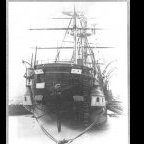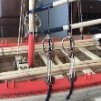Supplies of the Ship Modeler's Handbook are running out. Get your copy NOW before they are gone! Click on photo to order.
×
-
Posts
3,084 -
Joined
-
Last visited
Reputation Activity
-
 Jaager got a reaction from Bob Cleek in Polyurethane vs Lacquer vs Shellac
Jaager got a reaction from Bob Cleek in Polyurethane vs Lacquer vs Shellac
An old wood finishing book had instructions for French polish. The instructions were to use a cloth pad that had a small quantity of Linseed oil in the middle which was then soaked with shellac. The pad was to be rubbed on the wood surface with constant movement and a jet takeoff removal. Otherwise the cloth will leave its weave pattern on the finish - which was to be only a wet layer.
I took this to mean that French polish is primarily shellac with a small admixture of polymerizing oil. It seems to me that Tung oil could be used instead of Linseed oil.
-
 Jaager got a reaction from druxey in The arming and fitting of English ships of war 1600 to 1815 by Brian Lavery
Jaager got a reaction from druxey in The arming and fitting of English ships of war 1600 to 1815 by Brian Lavery
Dave,
Unless you intend to build for an academic audience and for a contest where the reward is the model becoming a museum exhibit, except for maybe some very specific details, you should consider the AOTS series to be close enough. For long lived ships, a specific version is selected. It may not be the version that you wish to model, so keep that in mind.
Some of the vessels are complete reconstructions. Nothing definitive is known about their actual lines. For those vessels, as with kits purporting to be their models, what those AOTS volumes represent are models of the reconstruction. e.g. Susan Constant, Mary Rose, the Columbus trio, ... not AOTS but would probably sell if they were: Revenge, Mayflower, Half Moon, Magellan's five We even have models of ships that are only creations of the mind of a fiction writer.
There is a range here of what is acceptable - from pure fantasy to completely documented using contemporary sources. I see nothing wrong with making educated guesses that are not anachronisms, but you would probably do the future a favor by inserting a bond paper -india ink script- document listing your guesses (- along with your name and the date) inside the hull. It is just a matter of defining your personal limits and being aware of that.
-
 Jaager got a reaction from Canute in Polyurethane vs Lacquer vs Shellac
Jaager got a reaction from Canute in Polyurethane vs Lacquer vs Shellac
An old wood finishing book had instructions for French polish. The instructions were to use a cloth pad that had a small quantity of Linseed oil in the middle which was then soaked with shellac. The pad was to be rubbed on the wood surface with constant movement and a jet takeoff removal. Otherwise the cloth will leave its weave pattern on the finish - which was to be only a wet layer.
I took this to mean that French polish is primarily shellac with a small admixture of polymerizing oil. It seems to me that Tung oil could be used instead of Linseed oil.
-
 Jaager got a reaction from mtaylor in Atlantica by Wintergreen – Scale 1:30 - POF - sail training ketch - a smack of English heritage
Jaager got a reaction from mtaylor in Atlantica by Wintergreen – Scale 1:30 - POF - sail training ketch - a smack of English heritage
Hakan,
I got that the Balsa comment was meant in jest. I apologize if my response came across as an insult. I took it as an opportunity to broadcast another shot at that terrible species of wood out to the world.
In my mind, I imagine that inside shaping frames that are widely spaced apart is a totally unfun procedure.
I fill all of the spaces with Pine that is temporarily bonded. The solid hull keeps the edges of the frames crisp and it is more difficult to remove too much while shaping and faring. As I said in another thread, I am still looking for an easy to remove temporary bonding agent that can stand up to the sheer forces of shaping and does not leave a tedious to remove residue, when I kill the bond after the fillers have done their job and I punch them out.
I will offer another shot. Using Balsa as a filler for POB is probably one of those things that appear to be a useful idea, but later prove to be a bad one. It is probably just as likely to crush as it is to cut, plane, or rasp. The feel of working it is a bit creepy. Construction Pine is probably much more efficient to work and less expensive.
Pine is a joy to plane.
The worst dust producer for me is the rounded end of a 4x36 bench belt sander (80 grit) removing the inside of a sandwich of 6 or 8 frames at the stern or bow. The bevel is significant so there is a lot of wood to remove. That angle grinder disk can produce a cloud that no vac can totally collect.
-
 Jaager got a reaction from mtaylor in Atlantica by Wintergreen – Scale 1:30 - POF - sail training ketch - a smack of English heritage
Jaager got a reaction from mtaylor in Atlantica by Wintergreen – Scale 1:30 - POF - sail training ketch - a smack of English heritage
Balsa is about the absolute worst species of wood for our uses.
Apple is about the best. Almost impossible to find in quantity here.
The moulded dimension is what is seen on the cross section view (Body plan). Thickest at the keelson and thinnest at the rail.
All of the removal - but the shouting - should be done on the individual frame before adding it to the hull.
(Unless you are into self torture and frustration, you want all of frames to be as bends. Bend = a pair of frames with timbers that overlap each butt joint of its partner. - A raw end grain to end grain joint is a very weak bond. As in: no bond at all.)
Sanding - grit matters. Fast = course. But then it must be walked down to smooth using ever finer grits.
A machine is faster. For inside a hull - about the best machine that I have found is this:
https://www.kaleas.de//kaleas.cgi?action=show&sessionID=53362980167228376253362980&lang=en&page=shop-produktliste.html&cat=32&subcat=3230&catname=grinding, planing&arcode=x
But choose the Right Angle grinder. Use very light force, someone here had a part in the drive chain wear out.
There is a chuck attachment for the right angle unit for bits and burrs.
The belt sander ( comes up with the link) will REALLY eat wood fast - too fast if you are not careful - and it will quickly throw the belt - I hold it with a piece of flat scrap wood extending over the top part of the belt to keep it on.
https://www.kaleas.de//kaleas.cgi?action=show&sessionID=53362980167228376253362980&lang=en&page=shop-produktliste.html&cat=32&subcat=3280&catname=power supply&arcode=x
The DC power supply works with a variety of tools, but I am not sure very many are worth it when up against their single purpose competitors.
-
 Jaager got a reaction from mtaylor in Asian pear wood
Jaager got a reaction from mtaylor in Asian pear wood
Callery Pear - a group of ornamental Pear trees whose wood is also excellent for our use. The color is darker. The Web says that Pyrus calleryana is a native of China and Vietnam.
Masa, looks like you have found a wonderful timber. My impulse would be to be greedy and hoard as much as I could.
-
 Jaager got a reaction from tkay11 in The arming and fitting of English ships of war 1600 to 1815 by Brian Lavery
Jaager got a reaction from tkay11 in The arming and fitting of English ships of war 1600 to 1815 by Brian Lavery
Dave,
Unless you intend to build for an academic audience and for a contest where the reward is the model becoming a museum exhibit, except for maybe some very specific details, you should consider the AOTS series to be close enough. For long lived ships, a specific version is selected. It may not be the version that you wish to model, so keep that in mind.
Some of the vessels are complete reconstructions. Nothing definitive is known about their actual lines. For those vessels, as with kits purporting to be their models, what those AOTS volumes represent are models of the reconstruction. e.g. Susan Constant, Mary Rose, the Columbus trio, ... not AOTS but would probably sell if they were: Revenge, Mayflower, Half Moon, Magellan's five We even have models of ships that are only creations of the mind of a fiction writer.
There is a range here of what is acceptable - from pure fantasy to completely documented using contemporary sources. I see nothing wrong with making educated guesses that are not anachronisms, but you would probably do the future a favor by inserting a bond paper -india ink script- document listing your guesses (- along with your name and the date) inside the hull. It is just a matter of defining your personal limits and being aware of that.
-
 Jaager got a reaction from bruce d in Best Spindle Sander for Ship Modelling
Jaager got a reaction from bruce d in Best Spindle Sander for Ship Modelling
For jobs where the surface being worked is 90 degrees - like the easy way to do deck beams or a stem - a table is good to have. For sanding a group of 6-8 frames between any two stations - a table just gets in the way.
Where wanting to go slower than 1700 RPM may be an impulse, I find using a finer grit works better.
-
 Jaager got a reaction from Keith Black in Atlantica by Wintergreen – Scale 1:30 - POF - sail training ketch - a smack of English heritage
Jaager got a reaction from Keith Black in Atlantica by Wintergreen – Scale 1:30 - POF - sail training ketch - a smack of English heritage
Hakan,
I got that the Balsa comment was meant in jest. I apologize if my response came across as an insult. I took it as an opportunity to broadcast another shot at that terrible species of wood out to the world.
In my mind, I imagine that inside shaping frames that are widely spaced apart is a totally unfun procedure.
I fill all of the spaces with Pine that is temporarily bonded. The solid hull keeps the edges of the frames crisp and it is more difficult to remove too much while shaping and faring. As I said in another thread, I am still looking for an easy to remove temporary bonding agent that can stand up to the sheer forces of shaping and does not leave a tedious to remove residue, when I kill the bond after the fillers have done their job and I punch them out.
I will offer another shot. Using Balsa as a filler for POB is probably one of those things that appear to be a useful idea, but later prove to be a bad one. It is probably just as likely to crush as it is to cut, plane, or rasp. The feel of working it is a bit creepy. Construction Pine is probably much more efficient to work and less expensive.
Pine is a joy to plane.
The worst dust producer for me is the rounded end of a 4x36 bench belt sander (80 grit) removing the inside of a sandwich of 6 or 8 frames at the stern or bow. The bevel is significant so there is a lot of wood to remove. That angle grinder disk can produce a cloud that no vac can totally collect.
-
 Jaager got a reaction from thibaultron in All our problems are solved: post your dodgy solutions
Jaager got a reaction from thibaultron in All our problems are solved: post your dodgy solutions
We had one in the bathroom in the 1950's. The heat source for the house was an on oil burning furnace under a grating in the hall. More than one kid at the time 1"x1" or so grid pattern burns from falling on a red hot grate.
That was a step up from a coal burning furnace that required blackgang work from an inhabitant.
-
 Jaager got a reaction from James G in Atlantica by Wintergreen – Scale 1:30 - POF - sail training ketch - a smack of English heritage
Jaager got a reaction from James G in Atlantica by Wintergreen – Scale 1:30 - POF - sail training ketch - a smack of English heritage
Hakan,
I got that the Balsa comment was meant in jest. I apologize if my response came across as an insult. I took it as an opportunity to broadcast another shot at that terrible species of wood out to the world.
In my mind, I imagine that inside shaping frames that are widely spaced apart is a totally unfun procedure.
I fill all of the spaces with Pine that is temporarily bonded. The solid hull keeps the edges of the frames crisp and it is more difficult to remove too much while shaping and faring. As I said in another thread, I am still looking for an easy to remove temporary bonding agent that can stand up to the sheer forces of shaping and does not leave a tedious to remove residue, when I kill the bond after the fillers have done their job and I punch them out.
I will offer another shot. Using Balsa as a filler for POB is probably one of those things that appear to be a useful idea, but later prove to be a bad one. It is probably just as likely to crush as it is to cut, plane, or rasp. The feel of working it is a bit creepy. Construction Pine is probably much more efficient to work and less expensive.
Pine is a joy to plane.
The worst dust producer for me is the rounded end of a 4x36 bench belt sander (80 grit) removing the inside of a sandwich of 6 or 8 frames at the stern or bow. The bevel is significant so there is a lot of wood to remove. That angle grinder disk can produce a cloud that no vac can totally collect.
-
 Jaager got a reaction from modeller_masa in Asian pear wood
Jaager got a reaction from modeller_masa in Asian pear wood
Callery Pear - a group of ornamental Pear trees whose wood is also excellent for our use. The color is darker. The Web says that Pyrus calleryana is a native of China and Vietnam.
Masa, looks like you have found a wonderful timber. My impulse would be to be greedy and hoard as much as I could.
-
 Jaager got a reaction from shipman in The arming and fitting of English ships of war 1600 to 1815 by Brian Lavery
Jaager got a reaction from shipman in The arming and fitting of English ships of war 1600 to 1815 by Brian Lavery
Dave,
Unless you intend to build for an academic audience and for a contest where the reward is the model becoming a museum exhibit, except for maybe some very specific details, you should consider the AOTS series to be close enough. For long lived ships, a specific version is selected. It may not be the version that you wish to model, so keep that in mind.
Some of the vessels are complete reconstructions. Nothing definitive is known about their actual lines. For those vessels, as with kits purporting to be their models, what those AOTS volumes represent are models of the reconstruction. e.g. Susan Constant, Mary Rose, the Columbus trio, ... not AOTS but would probably sell if they were: Revenge, Mayflower, Half Moon, Magellan's five We even have models of ships that are only creations of the mind of a fiction writer.
There is a range here of what is acceptable - from pure fantasy to completely documented using contemporary sources. I see nothing wrong with making educated guesses that are not anachronisms, but you would probably do the future a favor by inserting a bond paper -india ink script- document listing your guesses (- along with your name and the date) inside the hull. It is just a matter of defining your personal limits and being aware of that.
-
 Jaager got a reaction from Wintergreen in Atlantica by Wintergreen – Scale 1:30 - POF - sail training ketch - a smack of English heritage
Jaager got a reaction from Wintergreen in Atlantica by Wintergreen – Scale 1:30 - POF - sail training ketch - a smack of English heritage
Balsa is about the absolute worst species of wood for our uses.
Apple is about the best. Almost impossible to find in quantity here.
The moulded dimension is what is seen on the cross section view (Body plan). Thickest at the keelson and thinnest at the rail.
All of the removal - but the shouting - should be done on the individual frame before adding it to the hull.
(Unless you are into self torture and frustration, you want all of frames to be as bends. Bend = a pair of frames with timbers that overlap each butt joint of its partner. - A raw end grain to end grain joint is a very weak bond. As in: no bond at all.)
Sanding - grit matters. Fast = course. But then it must be walked down to smooth using ever finer grits.
A machine is faster. For inside a hull - about the best machine that I have found is this:
https://www.kaleas.de//kaleas.cgi?action=show&sessionID=53362980167228376253362980&lang=en&page=shop-produktliste.html&cat=32&subcat=3230&catname=grinding, planing&arcode=x
But choose the Right Angle grinder. Use very light force, someone here had a part in the drive chain wear out.
There is a chuck attachment for the right angle unit for bits and burrs.
The belt sander ( comes up with the link) will REALLY eat wood fast - too fast if you are not careful - and it will quickly throw the belt - I hold it with a piece of flat scrap wood extending over the top part of the belt to keep it on.
https://www.kaleas.de//kaleas.cgi?action=show&sessionID=53362980167228376253362980&lang=en&page=shop-produktliste.html&cat=32&subcat=3280&catname=power supply&arcode=x
The DC power supply works with a variety of tools, but I am not sure very many are worth it when up against their single purpose competitors.
-
 Jaager got a reaction from Keith Black in Atlantica by Wintergreen – Scale 1:30 - POF - sail training ketch - a smack of English heritage
Jaager got a reaction from Keith Black in Atlantica by Wintergreen – Scale 1:30 - POF - sail training ketch - a smack of English heritage
Balsa is about the absolute worst species of wood for our uses.
Apple is about the best. Almost impossible to find in quantity here.
The moulded dimension is what is seen on the cross section view (Body plan). Thickest at the keelson and thinnest at the rail.
All of the removal - but the shouting - should be done on the individual frame before adding it to the hull.
(Unless you are into self torture and frustration, you want all of frames to be as bends. Bend = a pair of frames with timbers that overlap each butt joint of its partner. - A raw end grain to end grain joint is a very weak bond. As in: no bond at all.)
Sanding - grit matters. Fast = course. But then it must be walked down to smooth using ever finer grits.
A machine is faster. For inside a hull - about the best machine that I have found is this:
https://www.kaleas.de//kaleas.cgi?action=show&sessionID=53362980167228376253362980&lang=en&page=shop-produktliste.html&cat=32&subcat=3230&catname=grinding, planing&arcode=x
But choose the Right Angle grinder. Use very light force, someone here had a part in the drive chain wear out.
There is a chuck attachment for the right angle unit for bits and burrs.
The belt sander ( comes up with the link) will REALLY eat wood fast - too fast if you are not careful - and it will quickly throw the belt - I hold it with a piece of flat scrap wood extending over the top part of the belt to keep it on.
https://www.kaleas.de//kaleas.cgi?action=show&sessionID=53362980167228376253362980&lang=en&page=shop-produktliste.html&cat=32&subcat=3280&catname=power supply&arcode=x
The DC power supply works with a variety of tools, but I am not sure very many are worth it when up against their single purpose competitors.
-
 Jaager got a reaction from Canute in All our problems are solved: post your dodgy solutions
Jaager got a reaction from Canute in All our problems are solved: post your dodgy solutions
We had one in the bathroom in the 1950's. The heat source for the house was an on oil burning furnace under a grating in the hall. More than one kid at the time 1"x1" or so grid pattern burns from falling on a red hot grate.
That was a step up from a coal burning furnace that required blackgang work from an inhabitant.
-
 Jaager got a reaction from mtaylor in The arming and fitting of English ships of war 1600 to 1815 by Brian Lavery
Jaager got a reaction from mtaylor in The arming and fitting of English ships of war 1600 to 1815 by Brian Lavery
Dave,
Unless you intend to build for an academic audience and for a contest where the reward is the model becoming a museum exhibit, except for maybe some very specific details, you should consider the AOTS series to be close enough. For long lived ships, a specific version is selected. It may not be the version that you wish to model, so keep that in mind.
Some of the vessels are complete reconstructions. Nothing definitive is known about their actual lines. For those vessels, as with kits purporting to be their models, what those AOTS volumes represent are models of the reconstruction. e.g. Susan Constant, Mary Rose, the Columbus trio, ... not AOTS but would probably sell if they were: Revenge, Mayflower, Half Moon, Magellan's five We even have models of ships that are only creations of the mind of a fiction writer.
There is a range here of what is acceptable - from pure fantasy to completely documented using contemporary sources. I see nothing wrong with making educated guesses that are not anachronisms, but you would probably do the future a favor by inserting a bond paper -india ink script- document listing your guesses (- along with your name and the date) inside the hull. It is just a matter of defining your personal limits and being aware of that.
-
 Jaager got a reaction from mbp521 in All our problems are solved: post your dodgy solutions
Jaager got a reaction from mbp521 in All our problems are solved: post your dodgy solutions
Next, it might be worth considering giving this layer some protection. I use white butcher paper, but a roll of 3 x1000 foot has become a bit dear. Home Depot or Slowes have small rolls of contractors paper (the stuff that you walk on in a model home). For a direct working surface, a 18"x12" x 1/4" piece of tempered glass - edge beveled - is a good glue and cut surface and is dead flat for glue ups.
A bit of a drift from being a "dodgy solution" unless you drop or use the glass as a hammering surface. A source of worry if you move a lot.
-
 Jaager got a reaction from GrandpaPhil in All our problems are solved: post your dodgy solutions
Jaager got a reaction from GrandpaPhil in All our problems are solved: post your dodgy solutions
Next, it might be worth considering giving this layer some protection. I use white butcher paper, but a roll of 3 x1000 foot has become a bit dear. Home Depot or Slowes have small rolls of contractors paper (the stuff that you walk on in a model home). For a direct working surface, a 18"x12" x 1/4" piece of tempered glass - edge beveled - is a good glue and cut surface and is dead flat for glue ups.
A bit of a drift from being a "dodgy solution" unless you drop or use the glass as a hammering surface. A source of worry if you move a lot.
-
 Jaager got a reaction from Canute in Dremel 4 Inch Table Saw Adventures, Modeling Tools
Jaager got a reaction from Canute in Dremel 4 Inch Table Saw Adventures, Modeling Tools
Jim sells bushings. They are excellent at adapting 1" arbors to fit a 4" table saw.
One more difference with using a table saw for milling lumber:
It really wants the stock it cuts to have at least one face surfaced and one side edged.
4x4 lumber that is S2S is actually 13/16" thick - about 1/4" is lost to the planer - but you pay for the full 1".
A band saw is more forgiving. I use rough lumber. The first cut of a rough edge riding the face of the fence is usually scrap, but sometimes the thickness sander is able to salvage something. A 4x4 board produces a 1" wide slice. I have to watch for checks. Any ripping of the slice wants the face that against the fence to be edged. For frame timbers, the condition of the edge does not matter ( except for deep checks ). I prefer 8x4 stock. I can get less waste by having a 2" wide surface to arrange my patterns.
( At 1:60 the floors for most ships need 3" and a first rate needs 4" for the frames close to the bow and stern. I do not use cant frames. Since it can't be seen, I now make those floors be two pieces. I have the cut at the edge of the keel and alternate the side in the sequence. )
-
 Jaager got a reaction from thibaultron in Dremel 4 Inch Table Saw Adventures, Modeling Tools
Jaager got a reaction from thibaultron in Dremel 4 Inch Table Saw Adventures, Modeling Tools
Jim sells bushings. They are excellent at adapting 1" arbors to fit a 4" table saw.
One more difference with using a table saw for milling lumber:
It really wants the stock it cuts to have at least one face surfaced and one side edged.
4x4 lumber that is S2S is actually 13/16" thick - about 1/4" is lost to the planer - but you pay for the full 1".
A band saw is more forgiving. I use rough lumber. The first cut of a rough edge riding the face of the fence is usually scrap, but sometimes the thickness sander is able to salvage something. A 4x4 board produces a 1" wide slice. I have to watch for checks. Any ripping of the slice wants the face that against the fence to be edged. For frame timbers, the condition of the edge does not matter ( except for deep checks ). I prefer 8x4 stock. I can get less waste by having a 2" wide surface to arrange my patterns.
( At 1:60 the floors for most ships need 3" and a first rate needs 4" for the frames close to the bow and stern. I do not use cant frames. Since it can't be seen, I now make those floors be two pieces. I have the cut at the edge of the keel and alternate the side in the sequence. )
-
 Jaager got a reaction from mtaylor in Dremel 4 Inch Table Saw Adventures, Modeling Tools
Jaager got a reaction from mtaylor in Dremel 4 Inch Table Saw Adventures, Modeling Tools
Jim sells bushings. They are excellent at adapting 1" arbors to fit a 4" table saw.
One more difference with using a table saw for milling lumber:
It really wants the stock it cuts to have at least one face surfaced and one side edged.
4x4 lumber that is S2S is actually 13/16" thick - about 1/4" is lost to the planer - but you pay for the full 1".
A band saw is more forgiving. I use rough lumber. The first cut of a rough edge riding the face of the fence is usually scrap, but sometimes the thickness sander is able to salvage something. A 4x4 board produces a 1" wide slice. I have to watch for checks. Any ripping of the slice wants the face that against the fence to be edged. For frame timbers, the condition of the edge does not matter ( except for deep checks ). I prefer 8x4 stock. I can get less waste by having a 2" wide surface to arrange my patterns.
( At 1:60 the floors for most ships need 3" and a first rate needs 4" for the frames close to the bow and stern. I do not use cant frames. Since it can't be seen, I now make those floors be two pieces. I have the cut at the edge of the keel and alternate the side in the sequence. )
-
 Jaager got a reaction from mtaylor in Dremel 4 Inch Table Saw Adventures, Modeling Tools
Jaager got a reaction from mtaylor in Dremel 4 Inch Table Saw Adventures, Modeling Tools
I do not think that you will find it helpful to opt for a blade with a smaller diameter. The height that a blade can rise above the table is set by the machine and is usually around 2" or less with a 10" blade. A 10" blade can be set to as small an exposure as anything smaller.
The target would be a 10" rip blade with as small a blade thickness as can be had for a quality blade.
I have an old Craftsman 7.5" - I think it was a contractors portable for its designed use.
I used a hollow ground planer blade - all steel - The kerf was less than other type blades. Because of the grind, the depth of cut was less for even a 7.5". The teeth were not designed for rip cuts thru thick stock. It tended to burn the wood if I was cutting 1" stock.
The message is not that a 10" saw will not be adequate for milling 1" stock - it certainly will. And it will probably be faster than a bandsaw. If you are careful with the feed, the cuts are almost always straight. The blades are much less likely to wander or do wedge cuts. It will not be easy, but with the right fence increment fixtures, which you will probably have to design and fabricate, the thickness of a cut can be just as controlled as a Byrnes.
The cost is:
That there will be significantly more loss of stock to kerf.
Doing multiple passes and flipping stock to cut thicker stock will probably be messy and need a lot of thickness sander work - more significant loss.
The degree of tissue damage possible because of inattention or poor technique is greater with a 10" than a Byrnes or a bandsaw.
A kickback missile will have significantly more kinetic energy.
-
 Jaager got a reaction from Canute in Dremel 4 Inch Table Saw Adventures, Modeling Tools
Jaager got a reaction from Canute in Dremel 4 Inch Table Saw Adventures, Modeling Tools
I do not think that you will find it helpful to opt for a blade with a smaller diameter. The height that a blade can rise above the table is set by the machine and is usually around 2" or less with a 10" blade. A 10" blade can be set to as small an exposure as anything smaller.
The target would be a 10" rip blade with as small a blade thickness as can be had for a quality blade.
I have an old Craftsman 7.5" - I think it was a contractors portable for its designed use.
I used a hollow ground planer blade - all steel - The kerf was less than other type blades. Because of the grind, the depth of cut was less for even a 7.5". The teeth were not designed for rip cuts thru thick stock. It tended to burn the wood if I was cutting 1" stock.
The message is not that a 10" saw will not be adequate for milling 1" stock - it certainly will. And it will probably be faster than a bandsaw. If you are careful with the feed, the cuts are almost always straight. The blades are much less likely to wander or do wedge cuts. It will not be easy, but with the right fence increment fixtures, which you will probably have to design and fabricate, the thickness of a cut can be just as controlled as a Byrnes.
The cost is:
That there will be significantly more loss of stock to kerf.
Doing multiple passes and flipping stock to cut thicker stock will probably be messy and need a lot of thickness sander work - more significant loss.
The degree of tissue damage possible because of inattention or poor technique is greater with a 10" than a Byrnes or a bandsaw.
A kickback missile will have significantly more kinetic energy.
-
 Jaager got a reaction from thibaultron in Dremel 4 Inch Table Saw Adventures, Modeling Tools
Jaager got a reaction from thibaultron in Dremel 4 Inch Table Saw Adventures, Modeling Tools
I do not think that you will find it helpful to opt for a blade with a smaller diameter. The height that a blade can rise above the table is set by the machine and is usually around 2" or less with a 10" blade. A 10" blade can be set to as small an exposure as anything smaller.
The target would be a 10" rip blade with as small a blade thickness as can be had for a quality blade.
I have an old Craftsman 7.5" - I think it was a contractors portable for its designed use.
I used a hollow ground planer blade - all steel - The kerf was less than other type blades. Because of the grind, the depth of cut was less for even a 7.5". The teeth were not designed for rip cuts thru thick stock. It tended to burn the wood if I was cutting 1" stock.
The message is not that a 10" saw will not be adequate for milling 1" stock - it certainly will. And it will probably be faster than a bandsaw. If you are careful with the feed, the cuts are almost always straight. The blades are much less likely to wander or do wedge cuts. It will not be easy, but with the right fence increment fixtures, which you will probably have to design and fabricate, the thickness of a cut can be just as controlled as a Byrnes.
The cost is:
That there will be significantly more loss of stock to kerf.
Doing multiple passes and flipping stock to cut thicker stock will probably be messy and need a lot of thickness sander work - more significant loss.
The degree of tissue damage possible because of inattention or poor technique is greater with a 10" than a Byrnes or a bandsaw.
A kickback missile will have significantly more kinetic energy.












